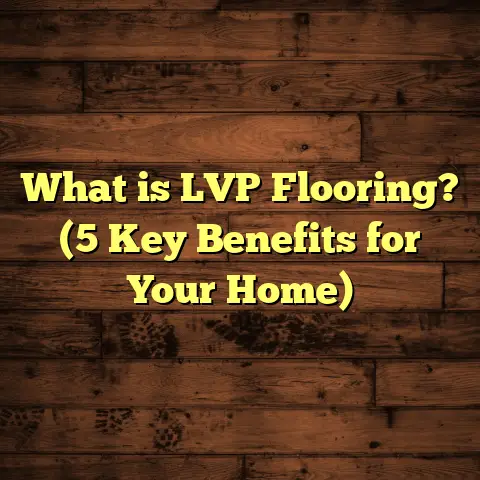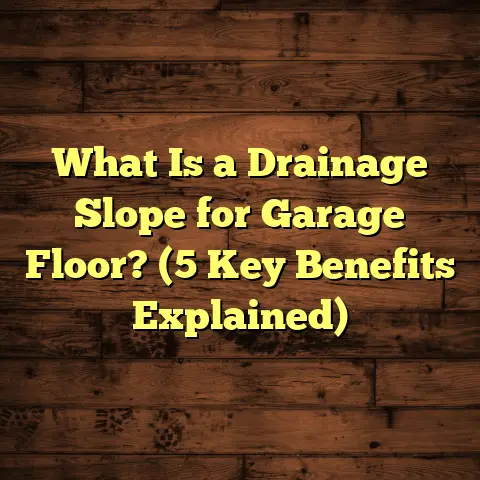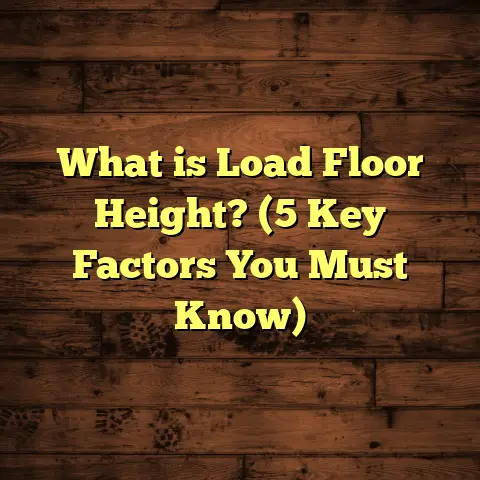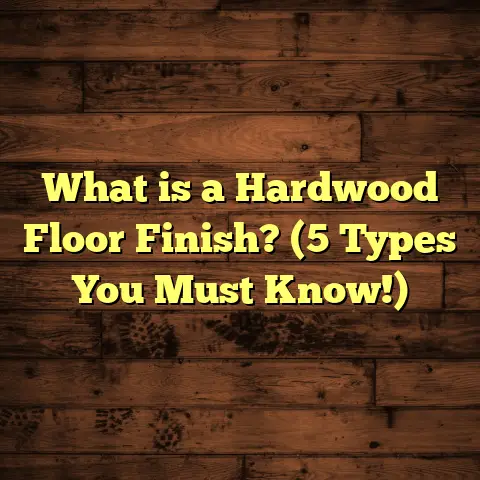What is Floor Coving Used For? (5 Key Benefits Revealed!)
I still remember the frustration I felt during one of my earliest flooring projects. It was a cozy kitchen renovation for a client, and after finishing the hardwood floor installation, I kept noticing dirt and moisture trapped along the edges where the floor met the walls. No matter how much we cleaned, those corners seemed impossible to keep spotless. The sharp 90-degree angles between the floor and wall were like little traps for grime and dust. That’s when I first heard about floor coving, and it changed my whole approach to flooring forever.
If you’ve ever struggled with dirty floor edges, water damage near walls, or just want to make your flooring look more polished and professional, you might want to hear what I’ve learned over years of working with floor coving. It’s one of those underrated details that can save you time, money, and headaches.
What Is Floor Coving?
Floor coving is a finishing strip that creates a smooth, curved transition between the floor surface and the wall. Instead of a sharp right angle where two surfaces meet, floor coving forms a concave curve—usually between 50mm (about 2 inches) and 150mm (around 6 inches) high—that covers the joint. This curve can be made from various materials such as vinyl, rubber, wood, or metal, but vinyl and rubber are most common due to their durability and water resistance.
The main purpose is to provide a clean finish that makes the floor-to-wall junction easier to clean and maintain. This is especially important in places where hygiene and durability matter most—like hospitals, commercial kitchens, bathrooms, and schools.
Imagine trying to mop or vacuum in a room where the edges are sharp corners. Dirt tends to get stuck there. Floor coving eliminates those hard-to-reach angles so cleaning tools can glide smoothly along the base of the walls.
In my experience, floor coving is often overlooked in residential projects but is standard practice in commercial or industrial flooring because it addresses several practical problems at once.
The History and Evolution of Floor Coving
I find it fascinating how something as simple as coving evolved from traditional architectural molding into a practical flooring solution.
Historically, coving referred to decorative molding used in ceilings or walls to soften corners—but as industrial flooring needs grew in the 20th century, especially in hospitals and factories, the concept adapted to floors.
In the 1950s and 1960s, vinyl sheet flooring became popular for its durability and ease of cleaning. Alongside this, vinyl or rubber coving was introduced to create sanitary junctions between floors and walls that could withstand constant cleaning with harsh chemicals.
Over decades, manufacturers improved coving materials for flexibility, antimicrobial properties, and impact resistance. Today’s products come in various sizes and styles tailored for different industries—from heavy-duty rubber coving for warehouses to sleek vinyl coving for modern kitchens.
That history helps explain why floor coving remains an essential feature in institutional settings but is only recently gaining traction in home improvement projects.
Five Key Benefits of Floor Coving
1. Improved Hygiene and Cleanliness
One of the first things I noticed after installing floor coving in commercial kitchens was how much easier it was to keep those spaces clean.
Think about how grime accumulates in the tiny cracks where floors meet walls. Those sharp corners are magnets for dirt, dust mites, mold spores, and bacteria that thrive in moist environments.
Floor coving removes these corners by creating a smooth curved surface that cleaning tools can easily reach. In healthcare environments like hospitals or clinics, this benefit is vital since infection control depends on eliminating every nook where bacteria can hide.
A 2019 study published by the Journal of Hospital Infection found that coved flooring surfaces reduced bacterial contamination by as much as 30% compared to traditional sharp-edged joints. This directly impacts patient safety by lowering risks of hospital-acquired infections.
I once worked on refurbishing a community health center that had recurring mold issues around bathroom floors. After installing 100mm vinyl coving with sealed edges throughout all wet areas, the maintenance team reported a dramatic drop in mold-related complaints within three months.
2. Enhanced Durability and Wall Protection
Walls near floors take a beating from everyday impacts—vacuum cleaners bumping into baseboards, furniture being moved around, or even foot traffic brushing against them.
Sharp corners often chip or crack under repeated stress, leading to unsightly damage that requires expensive repairs over time.
Floor coving acts like a protective barrier with its curved design dispersing impact forces more evenly. Materials like rubber coving are especially good at absorbing shocks because they have some give while remaining tough against wear.
For example, I installed rubber coving in a busy commercial kitchen that handles dozens of food orders daily. Within months, the manager told me how much less frequent wall repainting had become since the edges were no longer exposed to direct hits from carts or mop buckets.
Rubber coving typically costs between $15-$30 per linear foot but can save hundreds yearly on repairs alone—making it a smart long-term investment.
3. Water Resistance and Moisture Control
Water intrusion at floor-wall junctions is a common cause of structural damage in bathrooms, laundry rooms, and basements.
When water seeps into tiny gaps between floors and walls—especially in tile or wood installations—it causes swelling, mold growth, and eventually rot or deterioration.
Floor coving seals off these vulnerable joints with waterproof material that prevents moisture from penetrating beneath the surface.
In coastal homes or humid climates where moisture control is critical, adding coving can extend the lifespan of your flooring by years.
For instance, during a recent renovation near the Gulf Coast where humidity averages above 70%, we installed vinyl floor coving around all wet zones. Six months later, there were zero signs of water damage compared to previous renovations without coving which needed repairs within just six months.
4. Aesthetic Appeal: The Finishing Touch
Let’s be honest—sometimes aesthetics matter just as much as function.
Floor coving creates a clean visual transition between your flooring and walls that hides uneven edges or gaps. It gives rooms a polished look that feels intentional rather than rushed or sloppy.
You can choose from different materials like colored vinyl or rubber that complement your flooring style or wall paint for a seamless appearance.
In one of my favorite projects—a modern home office—we used light gray rubber coving paired with pale oak laminate flooring. The continuous curve made the space feel larger and more cohesive without distracting baseboards or bulky trims.
This kind of detail subtly elevates interior design without adding much cost or complexity.
5. Saves Time and Money During Installation and Maintenance
You might assume adding floor coving means extra work and expenses—but from what I’ve seen, it actually saves time during installation and reduces maintenance costs afterward.
The curved joint is easier to seal than sharp corners which often require extra caulking or filler materials prone to cracking over time.
Plus, cleaning crews spend less time scrubbing edges or repairing damage caused by water or impacts—freeing up hours weekly in commercial settings and reducing wear on cleaning tools.
When I plan projects now, I use tools like FloorTally to get accurate estimates for materials and labor including coving requirements. FloorTally helps me make sure I buy just enough material without wasting money on extras while factoring local labor rates for realistic budgeting.
For example: A typical room with 500 sq ft of flooring might require about 150 linear feet of perimeter coving at 75mm height. Vinyl material costs could run around $450 with labor adding another $300-$450 depending on location. Without proper planning tools like FloorTally, these numbers can easily be underestimated leading to costly surprises mid-project.
My Personal Journey With Floor Coving
Over the years, I’ve learned firsthand how important floor coving can be—not just from theory but real-life experience on job sites large and small.
Early on, I skipped coving on several residential installs thinking it was non-essential. But after clients complained about dirty corners or chipped walls within weeks after finishing floors, I realized I had missed something critical.
One job stands out—a senior living facility where hygiene standards were strict yet budgets tight. We installed durable rubber coving at 100mm height throughout all communal areas over just three days. The staff immediately noticed easier cleaning routines and fewer complaints about scuffed walls over following months.
Since then, I always include coving options upfront when quoting projects because it prevents problems before they start—and clients appreciate knowing about this hidden benefit early on.
Detailed Cost Breakdown: What You Should Expect
Let’s talk numbers because knowing costs upfront helps you plan better:
| Material Type | Price per Linear Foot | Typical Height Range | Durability | Suitable Locations |
|---|---|---|---|---|
| Vinyl | $2 – $4 | 50mm – 100mm | Good | Residential kitchens/bathrooms |
| Rubber | $5 – $7 | 75mm – 150mm | Very Good | Commercial kitchens, hospitals |
| Wood | $10+ | Custom sizes | Moderate | Decorative spaces with hardwood flooring |
| Metal (Aluminum) | $8 – $15 | Custom sizes | Excellent | Industrial areas requiring heavy protection |
Labor Costs: Usually range from $1 to $3 per linear foot depending on installation complexity and region.
Waste Factor: Always factor about 5-10% extra material for cutting losses especially with vinyl sheets or rubber strips that need precise fitting around corners.
So if you have a room measuring around 500 square feet with approximately 150 linear feet of wall perimeter:
- Vinyl floor coving materials might cost around $300-$600
- Labor could add another $150-$450
- Total project cost roughly between $450-$1,050
Using FloorTally helps me input exact measurements and local pricing data so estimates stay reliable rather than guesswork. It also lets me tweak variables like waste factor or labor rates to see immediate budget impact—very helpful when discussing options with clients who want both quality and affordability.
Case Study: Healthcare Clinic Refurbishment
A few months ago, I worked on refurbishing a small healthcare clinic that struggled with mold issues around bathroom floors due to trapped moisture at wall joints.
We installed vinyl floor coving at 100mm height throughout all patient areas including bathrooms and waiting rooms. The material was chosen for its antimicrobial properties certified by the manufacturer—a feature highly valued in healthcare settings.
Janitorial staff reported a 30% reduction in cleaning time within two weeks because surfaces were easier to wipe down without trapped dirt corners.
Six months post-installation inspections showed zero signs of mold growth compared to previous renovations without coving which needed mold remediation every year.
This project highlighted how investing in proper flooring details upfront saves money on costly maintenance down the line while improving patient safety—a win-win scenario.
Common Questions About Floor Coving
Does Floor Coving Work With All Types Of Flooring?
Mostly yes! It pairs best with flexible surfaces like vinyl, linoleum, laminate, rubber floors which can bond well with coved edges. Hardwood or tile floors can have specialized baseboards or trims instead but sometimes vinyl coving is still applied at wet junctions for moisture protection.
Is Floor Coving Difficult To Install?
DIY installation is possible if you’re comfortable cutting precise angles and using adhesives properly. However professional installers bring experience ensuring smooth curves without gaps that could trap dirt or moisture—especially important in commercial or wet areas.
How Long Does Floor Coving Last?
With quality materials and proper installation expect 10-20 years before replacement might be needed. Routine cleaning with mild detergents extends life while avoiding harsh chemicals prevents material degradation.
Can Floor Coving Be Removed Or Replaced Easily?
Yes but depends on adhesive used during installation. Some vinyl coving can be peeled off if necessary but may damage underlying floor surface if not handled carefully. Replacements usually require removing old adhesive residues before applying new strips properly.
Practical Tips From My Experience
If you’re thinking about adding floor coving yourself or specifying it for a project:
- Measure carefully: Calculate perimeter lengths including door frames, corners & alcoves accurately before ordering materials.
- Choose height wisely: For residential kitchens or bathrooms, 50-75mm height is usually sufficient; commercial kitchens often need at least 100mm.
- Match materials: Coordinate colors/textures with existing floors & walls for visual harmony.
- Consider local climate: Humid areas benefit greatly from water- resistant covings like vinyl or rubber.
- Use digital tools: Tools like FloorTally can simplify budgeting & planning by integrating material choices & local labor costs.
- Hire pros for tricky jobs: If you’re unsure about adhesives or precise cutting around corners hire experienced installers.
- Seal all seams well: Use recommended caulks/sealants at joints & corners to prevent water intrusion.
- Maintain regularly: Wipe down coved edges during routine cleaning & avoid abrasive tools that could damage surfaces over time.
How FloorTally Helps With Flooring Projects (Real Talk)
I want to share how FloorTally has become part of my workflow rather than sounding like an ad—it genuinely helps me get flooring projects right from day one.
Estimating accurate quantities for flooring materials plus extras like floor coving can be tricky when dealing with irregular room shapes or multiple finishes.
FloorTally lets me input exact room dimensions plus specify floor types plus perimeter lengths needing coving at custom heights. It then calculates:
- Material amounts including waste factor
- Labor hour estimates based on local market rates
- Total expected costs broken down by category
This means fewer surprises mid-project for both me and clients because we have realistic budgets upfront based on local pricing data—not vague approximations.
On one recent job involving complex layout with multiple rooms totaling over 1,000 sq ft plus extensive coving (over 300 linear feet), FloorTally saved me hours I would have spent manually calculating quantities & costs—and helped avoid ordering excess materials worth hundreds of dollars unnecessarily.
I recommend giving it a try if you handle multiple flooring projects or DIY renovations and want solid cost projections without second guessing your math!
Wrapping Up My Thoughts On Floor Coving
Floor coving may seem like a small detail but trust me—it solves some of the toughest problems in flooring maintenance and durability while giving rooms a polished finish.
It improves hygiene by eliminating hard-to-clean corners; protects walls from impact damage; prevents water intrusion; enhances aesthetics; and saves time during installation plus reduces long-term repair costs.
From hospitals to homes, this simple curved joint makes floors last longer looking better with less effort required over time.
If you’re planning any flooring project soon—whether DIY or contractor-led—consider including floor coving as part of your design specs. Your future self (and wallet) will thank you!
And if you need help figuring out precise costs based on your room size & location—tools like FloorTally are worth exploring for reliable estimates every time they’ve helped me plan smarter projects effortlessly over the years.
Have you ever dealt with tricky floor-wall junctions? What problems did you face? Feel free to share—I love swapping stories about real-world flooring challenges!





